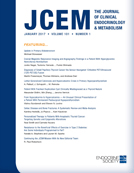-
Views
-
Cite
Cite
F. I. REYES, R. S. BORODITSKY, J. S. D. WINTER, C. FAIMAN, Studies on Human Sexual Development. II. Fetal and Maternal Serum Gonadotropin and Sex Steroid Concentrations, The Journal of Clinical Endocrinology & Metabolism, Volume 38, Issue 4, 1 April 1974, Pages 612–617, https://doi.org/10.1210/jcem-38-4-612
Close - Share Icon Share
ABSTRACT
Individual serum concentrations of FSH, “hCG-LH,” testosterone (T) and estradiol-17β (E2) were measured by radioimmunoassay in 46 male and 33 female human fetuses delivered by hysterotomy. Results were correlated with crownrump (CR) length and maternal serum concentrations of FSH, “hCG-LH” and E2. CR-lengths ranged from 4.2 to 24.0 cm corresponding to 9–25 weeks fetal age. Serum T levels in males (40–580 ng/100 ml) were significantly higher than those in females (< 20–130 ng/100 ml). A pattern in male serum T levels similar to that we have previously reported in testicular T concentrations was seen, with the highest values at 11–17 weeks fetal age (7–15.5 cm CR length) and a subsequent decline. Fetal serum E2 concentrations varied over a wide range (<20–>800 ng/100 ml) in both sexes, but showed no apparent relationship to CR length. Overall mean E2 levels in the females were higher than in the males. Both fetal and maternal “hCG-LH” levels declined with fetal age, with no apparent sex difference. The mean maternal-fetal “hCG-LH” ratio in paired samples was 31:1. The mean fetal serum “hCG-LH” concentration was significantly higher than in the newborn. There was a temporal relationship of high “hCG-LH” levels to the elevation of T concentration in sera of male fetuses. Serum FSH levels in the males were low or undetectable, but high FSH concentrations (8–240 μg/100 ml) were found in the females. These data provide further evidence for testicular T secretion at the time of genital differentiation, and suggest that the fetal Leydig cells are stimulated primarily by chorionic rather than pituitary gonadotropin at this critical time. On the other hand, ovarian follicular development appears to depend upon fetal pituitary gonadotropin secretion.





